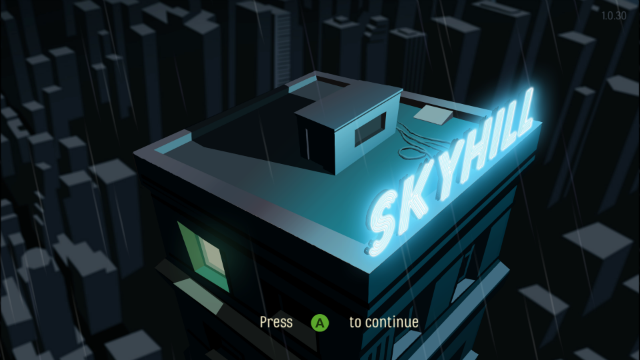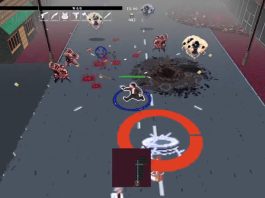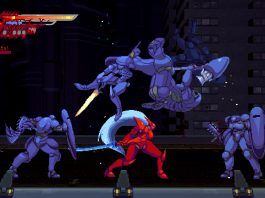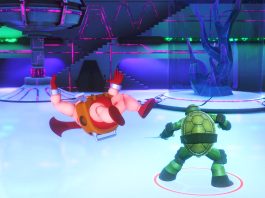As someone who doesn’t hold mobile games in high regard, I probably enjoyed Skyhill more than I could’ve expected. Even though the game is also available on PC, and now consoles as well, it undoubtedly has a mobile aesthetic going for it. Skyhill is a 2D roguelike game, with a heavy emphasis on exploration. In the endless sea of similar titles though, what makes this one stand out?
You play as Jason Perry, who resembles Ash Williams from The Evil Dead, dressed as Shaun from Shaun of the Dead. Jason is on a business trip and decides to spend his time in style, by staying at a luxury hotel suite – on the 100th floor. What could go wrong, right? Shit hits the fan pretty quick as Jason witnesses gruesome events unfolding on the TV in his room, and the building is now overrun by mutants. With supplies running low and no rescue in sight, Jason has no choice but to try and get out of the building on his own.
Upon starting a new game, you may select from three difficulty options – easy, normal, and hard – with an additional hardcore option initially locked. Unless you crave an unfair challenge, I would suggest starting on the easiest difficulty, and will later explain why.
To escape, you will have to descend one hundred floors, while fending off mutants, collecting items and managing resources – including hunger. In practice, it’s actually not as daunting as it may seem. Environments are randomly generated before each playthrough, so enemy and item locations can differ every time. Advancement is slow, but actions outside of combat can be sped up via the pause menu. You progress by guiding Jason downwards from the suite and clicking on each as-of-yet unexplored room. Each floor consists of a central staircase and an elevator, with a room on both sides.
Hold on, if there’s an elevator, why not take it straight to the first floor? The power supply throughout the building is inconsistent and there’s a broken fuse box every ten floors. It has to be fixed in order for the elevator to be operable. Upon interaction, Jason has a choice between fixing the fuse box with the required item or, if he doesn’t have it, improvising with materials at hand. The second option is almost always better, as it’s much easier than procuring materials for a specific item. It will rarely take more than two attempts to fix the fuse and, at worst, you will lose an item and slightly increase hunger.
Transitioning between rooms counts as a turn and each of these depletes the hunger meter by one unit. Using the elevator only consumes two units, regardless of the number of floors traversed. Jason starts out fairly satiated, but it’s important to scavenge for food to prevent him from starving, otherwise, he begins to lose health instead. Vending machines are scattered across the building and can be used to purchase useful resources, including food. When entering a room you may click on the available containers within that environment. Contents range from food and health items to materials and melee weapons. Items like notes and cassette recordings from other residents can also be found. Eventually, Jason discovers a VIP card which allows him to take the elevator back to his suite. It’s random, but the card is always located somewhere on the upper floors.
The suite itself is sort of like a safe haven; it contains a bed, a kitchen, and a workbench, which can be used for various purposes. Jason can sleep in the bed to restore some health in exchange for an equal amount of hunger. It’s a good option if you have an ample amount of food, but are low on healing items. The kitchen is used to prepare meals, though certain snacks and drinks, as well as health items, can be crafted on the go. Finally, the workbench can be employed to make use of the collected materials. New, powerful weapons can be crafted and other amenities improved. For instance, reinforcing the door decreases – and eventually nullifies – the chance of bad events occurring while asleep. Don’t neglect the door, I had a stick of butter stolen while enjoying a nap.
Exploration is frequently supplemented by combat encounters against mutants. These are heavily disfigured monstrosities resembling something you’d see in a Silent Hill game. Enemies have several varieties with additional differentiating features: some are wearing hard hats or sports jerseys. It adds a comical effect to an otherwise bleak game. Combat is turn-based and quite straightforward. You may select from up to three spots which Jason can attack and each spot has a probability of being hit. The lower the chance to hit, the higher the potential damage output, and vice versa. In addition, Jason can sometimes dodge attacks, perform critical hits, or receive an extra turn, at random. Despite the relative simplicity of combat, it’s important to prepare beforehand, as items can only be used during the first turn of any battle.
When you defeat a mutant, Jason earns experience points and can level up. Four skill points are awarded per level, which can be allocated among four different stats. Strength increases critical hit chance, while speed improves the likelihood of taking an extra turn. There’s also dexterity and accuracy, both of which improve the chances to evade and perform successful attacks, respectively. Beyond combat-related purposes, stats also affect weapons. Each weapon has a minimum stat requirement to be used properly. It can be equipped regardless, but its damage output would be severely reduced. Moreover, all weapons scale along with their associated stats, making them more powerful with each level. Weapons can also be salvaged for random materials, but weirdly enough, it’s not clear what materials are obtained without keeping track of the overall inventory.
There’s a limited amount of enemies during each playthrough and, hence, the number of levels that can be acquired. For this reason, the requirements for some weapons can’t be reached by any normal means. This is where perks come into play. For every ten completed floors, you unlock two perks; one passive, and one active. A combination of both can be selected upon a subsequent playthrough. Ironically, a passive perk is “active” at all times and, for example, can alter the distribution of skill points. An active perk, on the contrary, often has a cooldown period or can only be used once.
Progress comes from experience. On my first attempt, I learned that fixing the broken fuse boxes should be a top priority. Otherwise, travelling by stairs would consume food reserves too quickly. On my second playthrough, I realised that defeating the monsters on lower floors is just not feasible with basic weapons. So, I focused on saving materials for crafting better weapons as soon as possible. I tried numerous times before giving up, swallowing my pride, and switching to an easier difficulty. Completing the game became a breeze and I was rewarded for it with a galore of perks. Trying out new perks and discovering their often concealed potential is fun, and they do make life easier.
This is where a minor issue of Skyhill begins to surface and why starting out on an easier difficulty is better. Gameplay seems to be balanced towards having perks and completing the game is substantially more difficult without them. Sometimes, you won’t find a weapon on the first few floors or will discover food items when you’re in dire need of some health. This random luck factor basically determines whether or not you will even have a chance at reaching the exit. Additionally, on easier difficulties enemies have less health and victories award more experience points.
Because everything is generated randomly, certain characters or events may not occur, making each playthrough slightly different. And, to top it off, there are multiple endings to unlock, so Skyhill definitely has some replay value to it.
Despite falling in battle countless times, I didn’t feel discouraged to try again; I was eager to equip new perks, traverse the one hundred stories of hell and kiss the girl at the end (just kidding, there is no girl). However, while the ultimate conclusion was somewhat underwhelming, I enjoyed the journey itself and will more than likely return for more.












